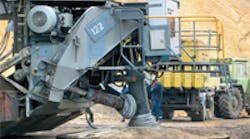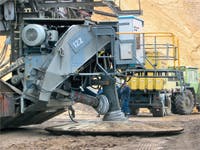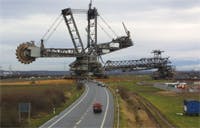Time certainly is money in mining. So it’s imperative at RWE Power AG’s Garzweiler and Inden lignite open-pit mines in Germany to transfer mined material from the excavation site to conveyors as quickly as possible. Gigantic bucket wheel excavators extract up to 240,000 m3 of earth per day at the site, and crawler excavators and trucks transfer the material to a nearby conveyor system.
Lignite, sometimes called brown coal, is the lowest rank of coal, and it is used primarily as fuel for steam turbines in power generation. Seams of lignite at the Garzweiler mine are between five and 20 m thick and lie up to 220 m underground in many places.
A need to move on
The mine is laid out in terraces with a variety of working levels. Most of the coal is extracted from the lowest levels. Excavators on the levels above remove the overburden — earth covering the layers. Belt-type conveyors transport the coal and overburden to distribution sites, which may be up to 85 km away.
The lignite is then moved to interim storage facilities in a coal bunker on the rim of the mine or transported directly to adjacent power plants or upgrading factories. Depending on distance, transportation is by conveyor or railway. The overburden is transported by conveyor to the depleted side of the mine, which is called the inner dump. Spreaders on the various work levels distribute the overburden and layer the earth terrace-style until the hole is backfilled.
Once an excavation site is exhausted, the distance to the conveyor can be prohibitively long to get material to the conveyor. Therefore, each conveyor station is supported by legs that each use three hydraulic cylinders to periodically walk closer to the excavation site.
In control
Designed and commissioned more than 40 years ago, the original system used analog control. Although reliable, the walking process was slow and somewhat labor intensive. Officials at RWE Power commissioned mine specialists from Bosch Rexroth to update the network of walking legs for the conveyor belt stations with the latest drive and control technology.
Each leg has decentralized components for controlling the three hydraulic cylinders. A central control takes care of master control functions and synchronizes motion of each leg to produce a walking motion. New hydraulic power units and control blocks together with electrically adjustable proportional valves combine to increase efficiency of the system. All ten modernized walking feet now feature identical controls and programs.
The walking legs can also be operated via remote radio control using a joystick from up to 50-m away without any manual intervention required.
Click on an image to watch a video of bucket wheel conveyors in action.



